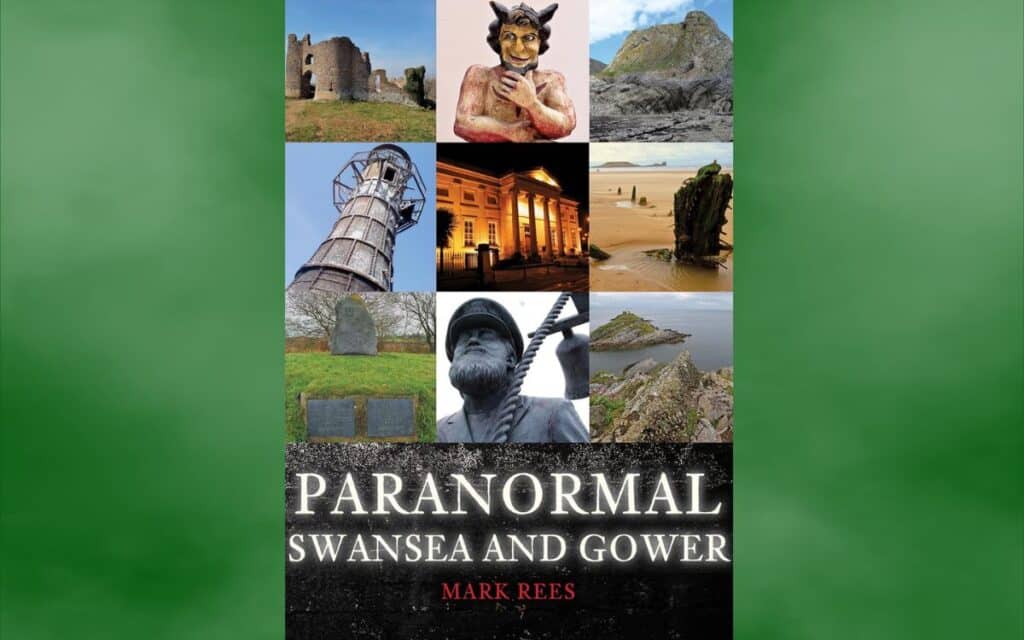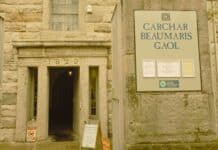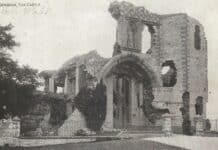Mark Rees, a South Wales journalist and author, talks to Spooky Isles about his new book, Paranormal Swansea and Gower

Interview with Mark Rees about Paranormal Swansea and Gower
SPOOKY ISLES: Congratulations on the new book, Mark! Paranormal Swansea and Gower is another fantastic deep dive into the mysterious corners of Wales. We’re excited to hear more about it! So, what was it about Swansea and Gower that made you want to focus on them next? Was there a particular story or legend that caught your attention?
MARK REES: With the possible exception of my hometown, Port Talbot, Swansea (the county, which includes Gower) is the most important place in Wales for both my writing and my ‘ghost hunting’ careers.
My first job in journalism was at the local press, writing about the arts for newspapers and magazines, including the South Wales Evening Post, which was, at the time, Wales’s best-selling newspaper.
Every Halloween, we’d put together lists of Wales’s ‘most haunted’ places, but it was always the same places and the same stories repeated every year. As somebody with an interest in the paranormal, I wanted to go out and discover new things.
I did this in two ways: firstly, by going back into the archives in search of long-lost hauntings, which formed the basis of my first spooky book, Ghosts of Wales: Accounts from the Victorian Archives (2017).
Secondly, unlike my colleagues who had better things to do with their spare time, I wanted to get out of the office and investigate these places in person. Not just write about some ‘white lady’ that was spotted in a castle decades ago; I was going to spend the night there and find out for myself.
These reports were published in the press, and eventually inspired what would become the Paranormal Wales series – a mixture of research, folklore, interviews and personal recollections, all combined to explore the history of Welsh hauntings.
You must have come across some fascinating new stories while researching this book – did anything surprise you this time around?
The biggest new revelation, which is so new it arrived after I’d finished the book and I had to squeeze in an extra paragraph or two, concerns the Rhondda Street poltergeist.
It’s arguably Swansea’s biggest poltergeist case, and it could give Pete the Poltergeist in Cardiff a run as Wales’s biggest poltergeist case.
In the 1960s, a young mother was forced to flee her home in Mount Pleasant when poltergeist activity began to threaten not only her safety but that of her children. It threw objects directly at her, smashing against doors as she pulled them close to defend herself, and upturned furniture, blocking doorways and barricading rooms. The police were seemingly baffled, unable to detect how an intruder could escape from a room with the door blocked up from the inside.
By pure chance – or maybe it wasn’t! – after sending the final draft of the book to my publisher, I was offered the opportunity to interview the mother and daughter about the case roughly half a century after the events. Along with my two friends who arranged it, Steve Balsamo and Ant Jones, we found out some amazing new details, some of which I was able to add to the book, and the rest will form part of a documentary that we’ll be screening in time for Halloween.
Swansea seems to have such a mix of history and hauntings, from Viking invasions to wartime bombings. How do you think these layers of history contribute to the city’s ghostly reputation?
I think these layers of history really highlight the differences between the paranormal accounts in Swansea and Gower.
Swansea, which was transformed beyond recognition during the Industrial Revolution and suffered a devastating three nights of bombing during the Second World War, shares much in common with the other heavily industrialised parts of south Wales. The ghosts of Swansea reflect these grittier periods and have more of a sinister edge.
Gower, on the other hand, while it might be right next door to Swansea on the map, shares more in common with the western side of Wales. It avoided much of the destruction and upheaval of more recent centuries and retains that idyllic, coastal charm. There’s a good reason why it was the first place in the UK to be designated an Area of Outstanding Natural Beauty.
As such, the accounts are deeply rooted in folklore, with more tales of fairies and devils, and fewer terrifying poltergeists. They do occasionally overlap, such as Pennard Castle which has both folk associations, being the home of fairies and the Gwrach-y-Rhibyn (Hag of the Night), and more modern-day hauntings. But overall, the ghosts of Gower seem to reflect the landscape and history of the peninsula, and you’re more likely to encounter spectral Vikings and smugglers in Gower than in Swansea.
If you had to pick a favourite spooky spot from the book, where would you send someone for a truly chilling experience?
I love Swansea Grand Theatre, although how chilling your experience is depends on when you visit – it isn’t that spooky at the height of panto season!
One of the most famous ghosts attached to the theatre is a traditional ‘white lady’, who has been encountered by many people since at least the 1960s. There’s something of a mystery surrounding her identity which has caused a lot of confusion over the decades.
For a long time, it was accepted as fact that she was the spirit of a famous singer who had died on the Titanic and was, in the afterlife, returning to her favourite theatre. It was only earlier this century that Ian Parsons, a theatre historian, looked into the details and discovered that this singer had actually died in her home in England, not on the Titanic, and further, she had died before the Grand had even opened. So, it was a nice story, but sadly everything about it was wrong!
However, there was a local performer with a much stronger claim to being the white lady. She performed at the theatre regularly, died tragically in a disaster at sea, and even had a link with Bram Stoker of Dracula fame. There’s a good change that she is the real ‘white lady’, and that her story was the inspiration behind the Titanic story – somewhere along the line the facts became blurred, and the name of the ship and the name of the performer were switched to better-known names.
I have friends who work at the theatre today and I’m always getting updates about spooky activity there so it’s definitely a place of ongoing interest.
The Swansea Devil sounds like a particularly creepy character – can you tell us a bit more about him and why he captured your imagination?
I love the Swansea Devil and, as someone whose academic qualifications are in art history, this ticks both the art history and the spooky boxes for me.
The Swansea Devil is a wooden statue that, so the legend goes, has a curse attached to it. An abbreviated version of the tale tells us that a disgruntled architect, who was hoping to land the commission for St Mary’s church in the heart of Swansea, plotted his revenge when the contract was awarded to Arthur Blomfield, a more illustrious architect from England.
He placed his ‘Devil’ on the building overlooking the church and prophesied that: ‘My devil will be able to leer and laugh, for at some future time he will see St Mary’s burning to the ground.’ That’s exactly what happened during the Second World War, when Swansea was targeted by the Nazis, who destroyed much of the city centre, burning down the church. The Swansea Devil, however, survived unscathed, and watched on as his enemy smouldered.
From there, it entered local folklore, and its life has been quite an adventure since. It was moved around the shopping centre directly opposite the church for a while, looking down at shoppers from various vantage points, and even disappeared from Swansea altogether for a few decades. It has a new permanent home in Swansea Museum, which also had a few ghost stories of its own to share.
Do you think Swansea and Gower’s eerie landscapes inspire more tales of the supernatural, or is it more about the people who tell the stories?
I think the landscape is a definite inspiration, and again reflects the differences between Swansea and Gower. It’s no accident that Gower, with its golden beaches and rolling sands, is haunted by spirits that can be heard drifting on the sea air, blowing in to land and scaring beachgoers.
Swansea, a far more built-up urban area, has more residential hauntings, which peaked in the Victorian age. Nowadays, it is the places of leisure that attract the most attention, with every theatre, museum and pub seemingly having its own resident ghost or two.
Of course, without the people there wouldn’t be anyone to tell the stories, and Swansea’s most famous storyteller, who also links Swansea and Gower nicely, was Dylan Thomas. He wrote about the paranormal in his fiction, telling spooky yarns of spirits following drinkers home from Wind Street, and there are accounts of him scaring actors down Gower by telling them ghost stories in the dead of night. Dylan is such an ever-present figure in the city that, as I expand upon in the book, he haunts it in a metaphorical and, some would say, literal sense.
What would you say to someone who’s on the fence about buying Paranormal Swansea and Gower? Why is this book a must-read for both locals and visitors alike?
One of the things I’m keen to do with my Paranormal books to make them practical guides for going out and exploring.
I like the idea of ‘reenchanting’ the world a little bit by putting these stories out there – or back out there, as the case may be – in the hope they’ll inspire people to look at the world a little differently. Whether it’s places that locals walk past every day or spots that visitors make a special effort to see, I hope readers will listen a little more carefully or look a little deeper into the shadows after reading the accounts.
From my own experience, when I’m visiting new places, I always check out historical sites first. If there’s a ghost story attached to a castle, pub, or wherever it might be, not only does it encourage me to go there, but it also adds a bit of magic to the exploration. You aren’t just looking around an old castle; you’re looking around an old haunted castle, and there’s always a chance that the white lady might, just might, appear at any moment. That’s the real magic of ghost stories.
On the other hand, I think anyone expecting profound insights into the latest theories in parapsychology might be disappointed! The Paranormal books don’t pretend to be dense academic works, but they are a comprehensive introductions to the paranormal history of an area that are easily accessible, packed with photos, and will hopefully inspire the reader to get out and about.
I’ve long maintained that you don’t need lots of money and fancy equipment to step into the world of the paranormal – just pick a place to start with, keep an open mind and see what happens!
Paranormal Swansea and Gower is available from Amberley Publishing.
Have you read Paranormal Swansea and Gower? Tell us your thoughts about Swansea and Gower in the comments section!







